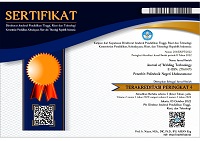Effect of variation of TIG welding current on tensile strength and hardness of aluminium A-6061
Abstract
Keywords
Full Text:
PDFReferences
G. Mathers, The welding of aluminium and its alloys. Woodhead publishing, 2002.
J. Ding, D. Wang, W. Ying, and D. U. Hui, “Effect of post weld heat treatment on properties of variable polarity TIG welded AA2219 aluminium alloy joints,” Trans. Nonferrous Met. Soc. China, vol. 24, no. 5, pp. 1307–1316, 2014.
D. G. Rethwisch, “William D. Callister, Jr.,” Mater. Sci. Eng., vol. 3.
Wiryosumarto H., Teknologi Pengelasan Logam. Jakarta: Erlangga, 2000.
H. Demir and S. Gündüz, “The effects of aging on machinability of 6061 aluminium alloy,” Mater. Des., vol. 30, no. 5, pp. 1480–1483, 2009.
A. Supandi, “Pengujian Kekuatan Mekanik Hasil Sambungan Las Aluminium 5083 Dengan Metode Las Gtaw (Gas Tungsten Arc Welding),” Apr. 2019.
Y. Liang, J. Shen, S. Hu, H. Wang, and J. Pang, “Effect of TIG current on microstructural and mechanical properties of 6061-T6 aluminium alloy joints by TIG–CMT hybrid welding,” J. Mater. Process. Technol., vol. 255, pp. 161–174, 2018.
A. Aditia, N. Nurdin, and A. S. Ismy, “Analisa kekuatan sambungan material AISI 1050 dengan ASTM A36 dengan variasi arus pada proses pengelasan SMAW,” J. Weld. Technol., vol. 1, no. 1, pp. 1–4, 2019.
L. Andewi, “Pengaruh Variasi Arus Pada Hasil Pengelasan TIG (Tungsten Inert Gas) Terhadap Sifat Fisis Dan Mekanis Pada Alumunium 6061,” 2016.
G. D. Haryadi and H. K. Kustomo, “Pengaruh Pengelasan TIG Filler Er 4043 Dan Post-Weld Heat Treatment Aluminium Paduan Terhadap Sifat Mekanik Dan Struktur Mikro,” ROTASI, vol. 17, no. 4, p. 189, Oct. 2015, doi: 10.14710/rotasi.17.4.189-196.
A. Naafila, A. Purnowidodo, and P. H. Setyarini, “Pengaruh Waktu Solution Treatment Terhadap Kekuatan Tarik Aluminium Paduan AA 7075-T6,” Pros. SENIATI, pp. 215–220, 2019.
A. K. Lakshminarayanan, V. Balasubramanian, and K. Elangovan, “Effect of welding processes on tensile properties of AA6061 aluminium alloy joints,” Int. J. Adv. Manuf. Technol., vol. 40, no. 3–4, pp. 286–296, 2009.
Y. I. Jie, J. Zhang, S. Cao, and P. Guo, “Effect of welding sequence on residual stress and deformation of 6061-T6 aluminium alloy automobile component,” Trans. Nonferrous Met. Soc. China, vol. 29, no. 2, pp. 287–295, 2019.
DOI: http://dx.doi.org/10.30811/jowt.v3i1.2226
Refbacks
- There are currently no refbacks.

This work is licensed under a Creative Commons Attribution-ShareAlike 4.0 International License.
Ciptaan disebarluaskan di bawah Lisensi Creative Commons Atribusi-BerbagiSerupa 4.0 Internasional.
Mailing Address:
Politeknik Negeri Lhokseumawe
Jl. Banda Aceh-Medan
Km. 280,3, Buketrata, Mesjid Punteut, Blang Mangat,
Kota Lhokseumawe, 24301
Propinsi Aceh,
Indonesia























